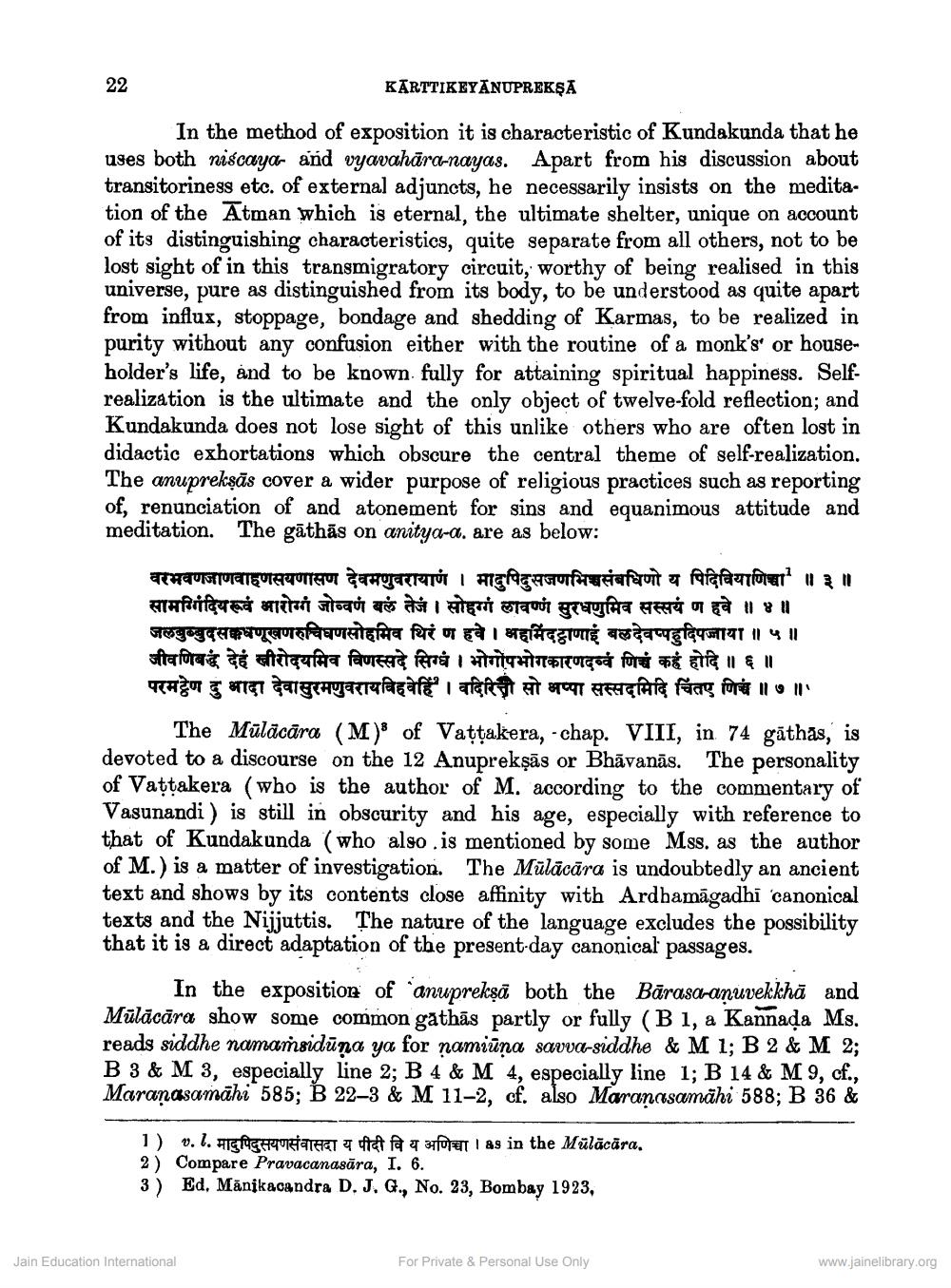________________
22
KĀRTTIKEYANUPREKŞA
In the method of exposition it is characteristic of Kundakunda that he uses both niscaya- and vyavahāra-nayas. Apart from his discussion about transitoriness etc. of external adjuncts, he necessarily insists on the meditation of the Atman which is eternal, the ultimate shelter, unique on account of its distinguishing characteristics, quite separate from all others, not to be lost sight of in this transmigratory circuit, worthy of being realised in this universe, pure as distinguished from its body, to be understood as quite apart from influx, stoppage, bondage and shedding of Karmas, to be realized in purity without any confusion either with the routine of a monk's or householder's life, and to be known fully for attaining spiritual happiness. Selfrealization is the ultimate and the only object of twelve-fold reflection; and Kundakunda does not lose sight of this unlike others who are often lost in didactic exhortations which obscure the central theme of self-realization. The anuprekşās cover a wider purpose of religious practices such as reporting of, renunciation of and atonement for sins and equanimous attitude and meditation. The gāthās on anitya-a. are as below:
वरमवणजाणवाहणसयणासण देवमणुवरायाणं । मादुपिदुसजणमिञ्चसंबधिणो य पिदिवियाणिचा ॥३॥ सामग्गिंदियरूवं आरोग्ग जोवणं बलं तेज । सोहग लावणं सुरवणुमिव सस्सयं ण हवे ॥४॥ जलबुब्बुदसाधणूखणरुचिघणसोहमिव थिरं ण हवे । अहमिंदट्ठाणाई बलदेवप्पहुदिपज्जाया ॥५॥ जीवणिबद्धं देहं खीरोदयमिव विणस्सदे सिग्छ । भोगोपभोगकारणदब्वं णिचं कह होदि ॥ ६ ॥ परमटेण दुभादा देवासुरमणुवरायविहवेहिं । वदिरिती सो भप्पा सस्सदमिदि चिंतए णिञ्च ॥७॥
The Mülācāra (M) of Vattakera, -chap. VIII, in 74 gāthas, is devoted to a discourse on the 12 Anuprekşās or Bhāvanās. The personality of Vattakera (who is the author of M. according to the commentary of Vasunandi ) is still in obscurity and his age, especially with reference to that of Kundakunda ( who also .is mentioned by some Mss. as the author of M.) is a matter of investigation. The Mülācāra is undoubtedly an ancient text and shows by its contents close affinity with Ardhamāgadhi canonical texts and the Nijjuttis. The nature of the language excludes the possibility that it is a direct adaptation of the present-day canonical passages.
In the exposition of anupreksā both the Bārasa-anuvekkha and Mülācāra show some common gathās partly or fully (B 1, a Kannada Ms. reads siddhe namaṁsidūna ya for namiūna savva-siddhe & M 1; B 2 & M 2; B 3 & M 3, especially line 2; B 4 & M 4, especially line 1; B 14 & M 9, cf., Maranasamāhi 585; B 22–3 & M 11-2, cf. also Maranasamähi 588; B 36 &
1) v.l. HIS
P ORTTHET a fa fa que l as in the Mülācāra, 2) Compare Pravacanasāra, I. 6. 3) Ed, Mānikacandra D.J. G., No. 23, Bombay 1923,
Jain Education International
For Private & Personal Use Only
www.jainelibrary.org




